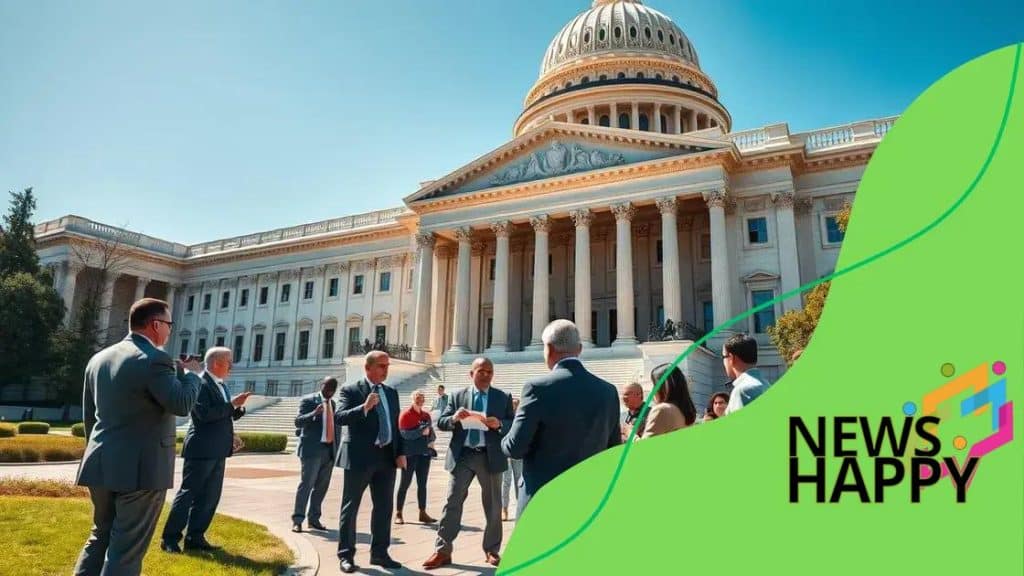Federal benefits cuts proposal 2025 could change everything

Anúncios
The federal benefits cuts proposal for 2025 risks increasing poverty. It also aims to reduce access to essential services. This would significantly impact low-income families and communities.
This proposal is making waves and raising eyebrows. With potential changes to crucial support programs, many are left wondering how these shifts might affect their lives. Let’s dive into the details.
The proposal could increase poverty and reduce access to essential services. It may significantly impact low-income families who rely on government support. Many are left wondering about these shifts.
Anúncios
Understanding the federal benefits cuts proposal
Understanding the federal benefits cuts proposal is crucial. Many citizens rely on these programs for support. This proposal outlines potential changes to vital services.
The proposal outlines potential changes to vital services and support systems. Learning about it can help you prepare for the upcoming years. It is designed to save money.
It is important to understand the proposal. It can help you learn about your rights. This knowledge can also help you explore new resources available to you.
Anúncios
What is the proposal about?

The proposal suggests reducing funding for several federal benefit programs. This can lead to a big impact on those receiving benefits. The goal is to save money.
The long-term effects on communities are still unclear. These changes could mean that fewer families qualify for benefits. The cuts may affect their ability to cover basic needs.
These changes may also affect their ability to cover basic needs such as food and housing. It’s important to watch how these decisions unfold. It’s vital to understand the implications.
Key elements of the proposal
The key elements include a reduction in support for low-income families. There are also changes to eligibility requirements for various programs. Potential cuts in funding for education are also on the table.
These changes could mean that fewer families qualify for benefits. The cuts may affect their ability to cover basic needs. This includes essential needs such as food and housing.
It’s important to watch how these decisions unfold. You should also be aware of the implications they may have. This knowledge can help you prepare.
What do stakeholders say?
Different groups have varied opinions about the proposal. Advocates for low-income families express concern. They believe these cuts could deepen poverty.
Some government officials argue that the cuts are necessary. They see this as a way to achieve economic reform. It’s a key part of their fiscal strategy.
Regardless of the stance, understanding this proposal is essential. It can help citizens know their rights. Keeping informed will empower people to advocate for their needs as changes roll out.
Next steps for citizens
The next steps for citizens are to stay updated. Keep up with the latest news regarding the proposal. Engage with community programs for support.
It is also important to contact your local representatives. You can voice your opinions and concerns. Being active in these discussions creates a voice for those affected.
Ultimately, it is vital for all of us to understand and engage with these changes thoughtfully. This can help create a positive outcome for many. Being active in the process is key.
Potential impacts on low-income families
The potential impacts on low-income families are significant and multifaceted. These changes can affect everyday needs. This includes food, housing, and healthcare.
Financial instability can increase when benefits are cut. Many low-income families rely on federal assistance to pay bills. A reduction in these benefits may lead to difficult choices.
For instance, they may have to decide between paying for food or rent. When families lose access to essential services, their overall wellbeing declines. This impacts entire communities.
Effects on financial stability
Financial instability can increase when benefits are cut. Many low-income families rely on federal assistance. They use it to pay bills and provide for their children.
A reduction in these benefits may lead to difficult choices. They may have to decide between paying for food or rent. This creates significant stress.
When families lose access to essential services, their overall wellbeing declines. These cuts don’t just affect individuals. They impact entire communities.
Access to essential services
Healthcare services may become less accessible. Food insecurity could rise with reduced nutrition assistance. Education programs might see funding cuts, impacting children’s future.
When families lose access to essential services, their overall wellbeing declines. This loss can lead to increased stress and anxiety. Families struggle to make ends meet.
These cuts don’t just affect individuals. They impact entire communities. Educators, social workers, and community leaders must come together to advocate for vulnerable populations.
Long-term effects on children
The long-term effects on children can be profound. Reduced access to healthcare can lead to untreated conditions. This can affect their development.
Food insecurity may hinder academic performance. This creates hurdles in education. Children in unstable environments are also likely to experience emotional and psychological challenges.
It is crucial to consider how these changes might influence the next generation. Community leaders must come together to advocate for vulnerable populations. They must help during these challenging times.
Reactions from various stakeholders
The reactions from various stakeholders are critical. They help in understanding the proposal’s far-reaching impacts. Different groups respond in unique ways.
Their responses are based on their interests and the populations they serve. These reactions can shape how the public perceives the proposal. They influence public opinion.
Understanding these reactions is key to a complete view. It helps to understand the different perspectives at play. It’s crucial for informed discussion.
Government officials’ perspectives
Government officials often argue that cuts are necessary for budget balancing. They also argue that they are needed for economic reform. They believe these changes will streamline services.
The changes may also redirect funds to essential areas. This opinion is seen as a tactical approach to fiscal management. It may overlook the immediate needs of vulnerable populations.
This perspective is focused on long-term fiscal health. However, it can have immediate impacts on people’s lives. It’s a balance between different priorities.
Advocacy group responses
Many advocacy groups are strongly opposed to the cuts. They warn of increased poverty and hardship for millions of people. Advocates are rallying communities to voice their concerns.
These groups emphasize that cutting benefits can lead to greater societal issues. They argue that the government should focus on improving efficiency. They want services to be expanded, not cut.
They advocate for better and more accessible support for those who need it most. They believe that this is a more effective long-term strategy. It’s a humane approach.
Public opinion and community reactions
The public’s reaction is mixed. Some community members are concerned about the long-term impacts on their families. Others may support the proposal for fiscal reasons.
Ongoing discussions in town halls reflect this diversity of opinion. A growing number of citizens are organizing grassroots campaigns. They are working to raise awareness of the issue.
Social media serves as a platform for sharing personal stories. It helps mobilize support. This bridges the gap between those affected and the broader community.
Historical context of benefit cuts
The historical context of benefit cuts provides insight. It helps us understand why these proposals emerge. It also shows us how they affect citizens.
Examining past instances of cuts can help us understand the cyclical nature of these decisions. It can also help us see their impacts on society. This provides a valuable perspective.
These trends often repeat, showing that social safety nets are vulnerable. They are susceptible to political and economic changes. This knowledge is important for the future.
Trends in federal funding
In recent decades, federal funding for benefit programs has seen fluctuations. During economic downturns, cuts often occur. Officials attempt to balance budgets.
These trends often repeat. This shows that social safety nets are vulnerable. They are susceptible to political and economic changes.
It is a recurring theme in history. The social safety net is often impacted by these decisions. This shows the importance of understanding these trends.
Notable historical cuts
The Personal Responsibility and Work Opportunity Reconciliation Act of 1996 significantly altered welfare programs. In 2013, budget sequestration led to immediate cuts. These were to food assistance programs.
These changes resulted in long-term challenges. This was for families who rely on these benefits. It illustrates how benefit cuts can lead to increased poverty.
It also highlights the ongoing struggle. This is the struggle between managing budgets and supporting low-income citizens. It is a recurring debate.
Public response to historical cuts
Historical responses to benefit cuts often involve public protests. There are also advocacy efforts. Community organizations step in to support affected families.
They urge government officials to reconsider their choices. These actions reflect the public’s understanding. Many citizens depend on these programs for basic needs.
It’s essential to learn from past decisions. Policymakers can then contemplate new proposals. Understanding the implications can foster a dialogue.
Analysis of proposed changes
The analysis of proposed changes is necessary. It helps to grasp its possible effects on individuals and families. By examining what these changes entail, we can understand who will be affected.
The analysis helps us understand how they will be affected. The proposal suggests several modifications. This includes stricter eligibility requirements.
It also includes potential reductions in funding for essential services. If implemented, many individuals currently receiving aid may find themselves ineligible. This is a key concern.
Key changes in the proposal
The proposal suggests several modifications to current benefit programs. These include stricter eligibility requirements. It also includes potential reductions in funding for essential services.
If implemented, many individuals currently receiving aid may find themselves ineligible. Such consequences can lead to a cycle of poverty. This is a cycle that is difficult to break.
For families struggling to make ends meet, the stakes are incredibly high. These cuts can have immediate and lasting impacts on their quality of life. This is why the analysis is important.
Potential consequences
Potential consequences include increased hardship for low-income families. There may also be a greater reliance on food banks and community programs. Higher rates of housing insecurity are also possible.
Such consequences can lead to a cycle of poverty. This is a cycle that is difficult to break. For families struggling to make ends meet, the stakes are incredibly high.
Cuts can have immediate and lasting impacts on their quality of life. These consequences are a major concern for many. It is important to consider them.
Broader implications
These proposed changes don’t only affect individuals. They can also impact local economies. When families have less money to spend, small businesses may see reduced sales.
This can create a ripple effect. This can lead to broader economic challenges. These changes could also place more pressure on community services and nonprofits.
As government support diminishes, these organizations may face increased demand. At the same time, they must grapple with limited resources. This raises important questions about sustainability and community resilience.
What can citizens do about it?

Citizens can play a crucial role in addressing the impacts of the cuts. By staying informed and taking action, individuals can help advocate for those affected. This is a key step.
One of the most important things is to raise awareness. Sharing information can educate others about the potential impacts. This can lead to increased public support.
When more people understand what is at stake, they are more likely to get involved. This can create a stronger voice for those affected. It is a vital part of the process.
Raise Awareness
One of the most important things citizens can do is to raise awareness. They can share information through social media or community events. This can educate others about the potential impacts.
When more people understand what is at stake, it can lead to increased public support. This is for protecting benefits. It is a vital first step.
By raising awareness, you can help people become more informed. This empowers them to take action. It can lead to a more organized response.
Engage with Local Representatives
It is important to contact local representatives. You can express your concerns and opinions. You can also attend town hall meetings.
You should encourage others to join in advocating for change. Staying engaged with elected officials is vital. Expressing your thoughts can lead to a dialogue.
When officials hear from their constituents, they are more likely to consider the human impact of their decisions. This is a key part of a functioning democracy.
Support Local Organizations
Another way to make a difference is to support local organizations. These groups assist families affected by the cuts. You can donate, volunteer, or spread the word.
This can help sustain programs that provide essential aid. Community groups often have resources that can help those in need navigate changes. They are a vital safety net.
By supporting these organizations, citizens contribute to a safety net. This is for individuals who may struggle during these challenging times. It is a proactive and positive step.
FAQ – Questions about the Federal Benefits Cuts Proposal
What are the main concerns regarding the proposed cuts?
The main concerns include increased poverty, reduced access to essential services, and negative impacts on low-income families.
How can citizens take action against the proposed cuts?
Citizens can raise awareness, engage with local representatives, support community organizations, and attend public meetings.
What historical events relate to these proposed cuts?
Past events include the welfare reforms of 1996 and budget cuts during economic downturns that significantly impacted low-income families.
Why is it important to stay informed about these changes?
Staying informed helps individuals understand their rights and the potential impacts on their communities, enabling effective advocacy for necessary support.





